LASER EXPERIMENTS OF SKB "PROMETEI"
Bulat M. Galeyev
ABSTRACT
The author presents information about laser apparatuses used in
performances and classifies them according to their physical
principles, using examples of work from his own studio.
Once a new technology is assimilated by art - after extensive
trial and error - a specific sphere of use results in which its
potential is presented in its optimal, organic form. For example,
the artistic form corresponding to light emanating from the
optical quantum generator (OQG) is the laser programme - an
audio-visual, light-musical performance usually held under an
artificial sky in a "laserium," similar to a planetarium
[1,2].
The laser has also been used in both dramatic and musical theatre
[3], where its unusual properties are usually used only as a
"spicy condiment" accompanying a traditional light palate. The
exoticism of the laser is most fully exploited in the eclectic
discotheque environment.
The laserium is based on maximal use of the possibilities of OQG
emanation. SKB "Prometei", the artists' group of which I am the
director, established contact long ago with Ivan Dryer, an
American light-musician and laserium pioneer. My group has many
videotapes of laser programmes produced by Dryer and by his
colleagues in different countries, including those at a laserium
in Budapest, Hungary, which I had the opportunity of visiting. On
the basis of my acquaintance and experience with this topic, I
would like to make the following statements.
There are three main methods of using laser light for artistic
purposes (with the exception of holography): (1) the projection
of laser beams into space, (2) the creation of interference
pictures on flat surfaces and (3) the creation of contour graphic
images through the high-speed scanning of a screen with a laser
beam.
The first method, resulting in laser-beam projection into space,
relies on the perception of high-power laser beams in air filled
with dust or smoke. Using mirrors (static or dynamic) to create
multiple reflections of the extremely thin rays, one can build a
kind of dynamic light architecture through transformations of
incorporeal beam constructions - such as a "web," "fan," "light
curtain," "cone," "arrow" or "bed-curtain" - made possible
through the use of rotating double-sided mirrors, reflecting
balls, cylindrical prisms, pyramids, bevelled rotating reflectors
with changing angles, etc. As a rule, the creation of images from
beams is performed through periodic interruptions of the beam,
i.e. in conjunction with a strobe effect, which can be
spectacular in itself. Without a strobe effect, images similar to
the fan are made through the use of diffraction gratings, which
split one ray into several. These gratings can have different
features and properties that are combined in various ways. A
critical component of these beam systems is a high-speed
commutator with a set of revolving semitransparent and reflective
mirrors, which allow the optimal and variable use of light from
one laser beam
[4]. It is common practice to use the "light
architecture" of a laser beam in conjunction with the physical
architecture of a space to achieve a desired effect; this method
is used not only in the interior of concert halls (i.e.
planetariums and theatres) but also under the open sky.
|
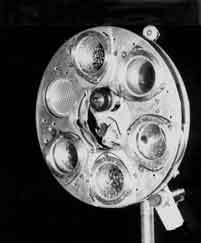 |
Fig. 1. Revolving head for laser projector, with rotating
cassettes. (Designer: Kamil Gimazutdinov). Inside every cassette
are formbuilding transparent discs. There can be two such discs
that rotate on one axis in different directions. Diffraction
gratings can be mounted in place of one of the form-building
discs. |
The second method, resulting in interference patterns on flat
surfaces, is based on the use of accidental phase modulation,
which occurs when a laser beam passing through optically
heterogeneous media is refracted at different points and angles
along its way, resulting in interference patterns projected on a
screen that change in contour and texture with each change in
media. The media can be made of solid transparent matter (e.g.
moving plates of nonuniform structure - usually round discs
mounted in a revolving cassette)
[5]. If a set of cassettes is
loaded in a revolving head (Fig. 1), one can exclude the element
of "chance" by experimenting with the selection of visual
effects. Sometimes an additional objective lens is used to
concentrate the light field. Sometimes traditional projection
objective lenses (transfocators) are mounted at the beam's point
of exit. These form-building methods can be used in the same
cassettes (to increase image possibilities) with diffraction
gratings (Fig. 2), curvilinear reflectors or a large moving lens
(for the deformation of light images).
|
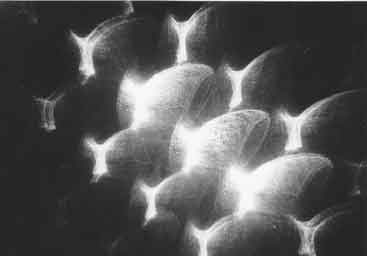 |
|
Fig. 2. Result of diffraction grating action on the interference
image. |
As mentioned earlier, one can project a beam through solid,
transparent plates; it is also possible to project a beam through
thin layers of flowing liquid or through gases or steam. Let us
look at the latter method, as tested by SKB "Prometei"
[6].
Figure 3a shows a laser beam reflected from a metallic, mirrored
surface layered over a lavsan pellicle (a thin, transparent,
reflective film) and thinly coated with a reflective substance
such as glycerine. When the beam is projected onto the mirrored
film, the pellicle will start to sag due to the heat and, acting
as a reflecting lens, it will stretch out and wash away the beam
(Fig. 3b). In this way, a contoured image with a fibrous structure
is formed on a screen. If the laser has enough power (1 or more
W), the lavsan will begin to steam, and the reflected beam will
pass through the streaming vapors. This streaming - or the
optical heterogeneities of a gas brought to a great heat - can
create the complex visual effects of fountains or explosions
within the initial image. If the pellicle is not moveable, the
beam will eventually burn through it (Fig. 3c). Therefore, the
pellicle must be moved slowly or rotated before the beam; the
image and its textural composition will then also transform
smoothly into fantastic pictures that resemble revolving
galaxies, space clouds and so on (Fig. 4a,b). The effect of the
transformation depends on the speed of the pellicle's movement,
the physical makeup of the pellicle and the composition of its
coating (e.g. colophony, vaseline or glycerine).
|
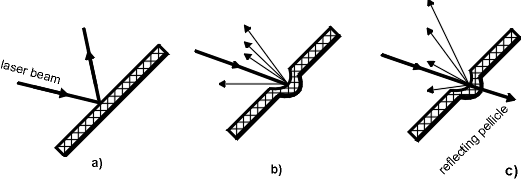 |
|
Fig. 3. Schematic figure demonstrating laser-light effects
enabled by a mirror lavsan pellicle. |
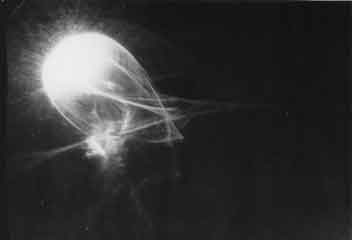 |
|
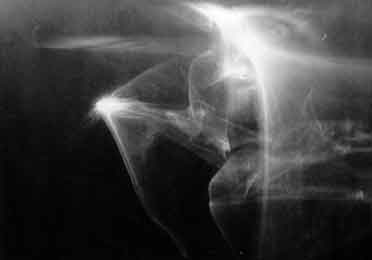 |
|
Fig. 4. Light effects resulting from burning lavsan
pellicles. |
To facilitate these methods, SKB "Prometei" has designed a
light-effect laser projector (Fig. 5). To make the projector,
reflecting pellicles were cut in the form of discs and mounted in
a revolving cassette. If the cassette rotates slowly, the laser
beam will burn through the pellicle. To prevent the beam from
becoming useless, we mounted a second disc behind the first one;
in case the second disc also burns, we mounted a third disc
behind the second. Because the burning pellicle still continues
to partially reflect light, three independent light images are
possible with one beam. All the cassettes are fixed on a platform
that moves forward very slowly. Finally the beam will burn
through the last pellicle, creating a spiral that allows maximal
use of the pellicle's shape. A variety of light effects on the
screen can be made by changing the pellicle's speed of revolution
or the cassette platform's speed of forward movement, or by
changing the angles of pitch of the cassette. The interference
pictures created using the second method are often used as
backgrounds onto which laser graphic pictures may be projected
(Fig. 6).
|
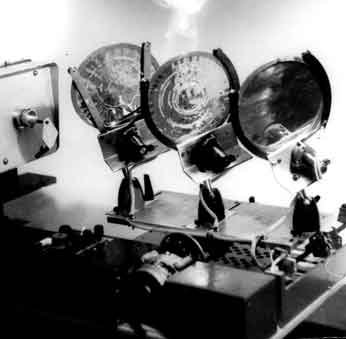 |
|
Fig. 5. Light-effect laser projector with three discs made from
reflecting lavsan pellicle.
(Designer: Rustem Saifullin).
|
|
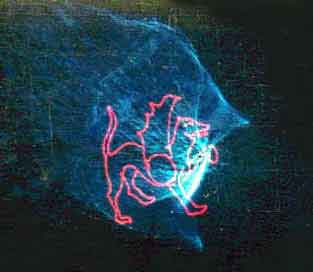 |
|
Fig. 6. Image resulting from projecting laser graphics onto an
interference background. |
o create such pictures, the third method, resulting in contour
graphic images through scanning a screen with a laser beam, is
employed
[7,8].
Achieving graphic effects through the use of
lasers is analogous to rapidly moving a lit cigarette or a
sparkler in dark air in order to produce a momentary image of
glowing lines. A laser beam produces a bright, blazing point when
immobile; it can produce graphic lines of light when moved across
a screen. This is achieved due to beam deviation along the
coordinates (x,y). This process can be described as similar to
that of the electromechanical oscillograph, except that instead
of an electronic ray, a thin laser beam is used
[9]. A vector
scanner is made either with a pair of small, lightweight mirror
reflectors oscillating with a frequency of hundreds of Hz, or
with optical deflectors (the scanner's angle is much smaller with
this method). The generation of Lissajous figures, as in an
ordinary oscillograph, is clearest with this method. One can -
with the help of a personal computer - input more complex signals
to the scanner and project other contour pictures (abstract or
concrete), which can be set into motion through animation methods
(Fig. 7). Different kinds of graphic information input tools
(e.g. mice and light pens) can be used, but the majority of
pictures projected in laseriums are supplied as special
programmes that can be shown serially. Necessary components of
such units are a brightness modulator and an additional scanner
to swing the image around slowly (on any trajectory). Sometimes
diffraction gratings (single or double, static or revolving) are
also used to multiply an image - for instance, in the production of
an ornamental pattern (Fig. 8). The generation of pictures
through a video scan of a laser beam (through the use of optical
deflectors) is a modification of this method. However, since this
method of obtaining an image is not economical, it is not usually
used at laseriums.
|
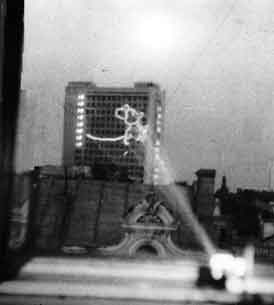 |
|
Fig.7. Animated mouse projected in the experiments
of SKB "Prometei" on the facade of a skyscraper at a distance of 750 m.
|
|
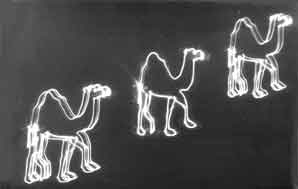 |
|
Fig. 8. Reproduction of graphic image
with the help of double diffraction gratings. |
The first laseriums opened in the United States after an official
premiere on 19 November 1973 (in Los Angeles, San Francisco,
Miami, Denver, St. Louis, Seattle, San Diego, New York, Boston
and other cities). Next, they opened in Canada (Toronto, 1975),
Japan (Kyoto, 1976), England (London, 1977), Hungary (Budapest,
1980) and other countries. In 1980, there was a short-lived
attempt to convert a Moscow planetarium into a laserium, but no
serial apparatus was produced in the states of the former USSR,
in contrast with the United States, where laseriums were designed
and produced by dozens of firms
[10,11].
Today, SKB "Prometei" produces laserium models and plans for a
company in Kazan, Russia, which plans to produce such an
apparatus for the Commonwealth of Independent States. Laser units
designed by SKB "Prometei" will be used in the spherical hall of
a future audio-visual center at the Kazan Conservatoire
[12].
References and Notes
- B. M. Galeyev,
"Laserium - New Kind of Show" (technical review).
In: Light-Music Theatre and Variety/Scientific-Practical
Seminar: Theses Reports (Kazan, Russia: KAI, 1991) pp.105-108.
- B. M. Galeyev,
"Beam-Artist", Tekhnika-Molodezhi, N.2 (1990) pp.5-7.
- B. M. Galeyev and R. F. Saifullin,
"Light-Music Devices" (Moscow: Energia, 1978) pp.58-60,128.
- V. M. Kozirev et al., "Light-Effect Reamering Laser Plant". In:
Light and Sound in Architecture/Scientific-Practical Seminar:
Theses Reports (Kazan, Russia: KAI, 1990) pp.62-64.
- R. F. Saifullin and R. V. Lerman, "Stage Laser of Simens Firm".
In: Light-Music in Theatre and Variety [1] pp.103-105.
- B. M. Galeyev et al., "Light-Effect Laser Device". In: Light and
Sound in Architecture [4] pp.58-62.
- V. P. Bukatin, "Laser Graphics Devices" (review of foreign
works). In: Light-Music in Theatre and Variety [1] pp.86-88.
- O. K. Gimazutdinov et al., "Laser Computer Graphics System". In:
Light-Music in Theatre and Variety [I] pp.86-88.
- A. Shumilov and E. Zhiganov, "Laser Light-Instrument",
Scenicheskaya Teknika i Tekhnologia, N. 1 (1983) pp.21-24.
- IV. Dolenko, "Laser Plants of Technological Artisans Firm".
In: Light-Music in Theatre and Variety [1] pp.109-110.
- I.V. Dolenko, "Laser System 'Summa Star'" (reference
information). In: Light-Music in Theatre and Variety [1] pp.98-100.
- B. M. Galeyev "Laseriums under the Dome of the Planetarium,"
Tekhmka Kino i Televidenia, N. 5 (1992).
Published in "Leonardo", 1994, Vol.27, No.5, pp.405-408.








